Orthogonal Polynomials in the Problems of Digital Information Processing
by Yaroslav Pyanylo 1,* ![]()
![]() , Valentyna Sobko 1
, Valentyna Sobko 1 ![]() , Halyna Pyanylo 1
, Halyna Pyanylo 1 ![]() , Oksana Pyanylo 2
, Oksana Pyanylo 2
1 Pidstryhach Institute for Applied Problems of Mechanics and Mathematics, National Academy of Sciences of Ukraine Lviv, 79060, Ukraine
2 CodeTiburon, Kharkiv, Ukraine
* Author to whom correspondence should be addressed.
Journal of Engineering Research and Sciences, Volume 2, Issue 5, Page # 1-9, 2023; DOI: 10.55708/js0205001
Keywords: Spectral Methods, Digital Information Processing, Signal Approximation and Filtering, Object Identification
Received: 23 December 2022, Revised: 15 March 2023, Accepted: 24 April 2023, Published Online: 30 May 2023
APA Style
Pyanylo, Y., Sobko, V., Pyanylo, H., & Pyanylo, O. (2023). Orthogonal Polynomials in the Problems of Digital Information Processing. Journal of Engineering Research and Sciences, 2(5), 1–9. https://doi.org/10.55708/js0205001
Chicago/Turabian Style
Pyanylo, Yaroslav, Valentyna Sobko, Halyna Pyanylo, and Oksana Pyanylo. “Orthogonal Polynomials in the Problems of Digital Information Processing.” Journal of Engineering Research and Sciences 2, no. 5 (May 1, 2023): 1–9. https://doi.org/10.55708/js0205001.
IEEE Style
Y. Pyanylo, V. Sobko, H. Pyanylo, and O. Pyanylo, “Orthogonal Polynomials in the Problems of Digital Information Processing,” Journal of Engineering Research and Sciences, vol. 2, no. 5, pp. 1–9, May 2023, doi: 10.55708/js0205001.
The paper examines spectral methods based on classical orthogonal polynomials for solving problems of digital information processing. Based on Jacobi polynomials, signal approximation methods are built to identify objects in the natural environment. Based on Chebyshev-Laguerre polynomials, methods of filtering multiplicative signal noises in linear filter models are proposed. Numerical experiments on model problems were conducted.
1. Introduction
To solve a broad spectrum of scientific and applied problems in many areas of natural science and technology, we use information that is stored in digital form. Input information is the value of measured parameters of the processes under investigation. The accuracy of the measured values depends on the measuring equipment and is not always high. Such problems as remote sensing data processing, electronic paramagnetic resonance (EPR), tomography, etc. [1] can be categorized as problems with unclear input information. Digital information is considered input for developing mathematical models of physical processes. Since the input information is specified with the inaccuracy of the measuring devices, their direct use in mathematical models can lead to significant differences in the desired results [2]. Consequently, preliminary processing of the input information is required [3, 4].
It becomes necessary to choose the processing method for cases when solutions to formulated applied problems that are based on digital input data should be obtained [3, 5, 6]. Сonsiderable amount of software packages has been developed to process digital information. [7, 8]
The total amount of worldwide commercial software applications is measured by several dozen. However, the number of the most famous and widely used commercial software applications for geoinformation systems can be limited to ten to fifteen [7, 8]. The world leaders of the software are ESRI packages (ArcGIS Desktop products), the MapInfo Professional package, the Idrisi package (developed at Clark University, USA), AutoCAD, ERDAS IMAGINE, ENVI, and Digitals [4].
Every process in which digital information is used has its peculiarities. These peculiarities cannot always be factored into the existing application programs. As a rule, these software packages are protected and do not allow any modifications In this regard, it is necessary to develop methods of processing input data that should make it possible to consider the particularity that occurs when exploring numerous natural phenomena.
Signal approximation, information compression, and signal filtering are the main problems in information processing [1]. There are various methods to solve data processing problems. Not all of them meet the requirements associated with the tasks that must be resolved. Spectral methods in orthogonal bases with fast transformation algorithms are the most used. The analysis of the orthogonal bases presented in the literature shows that the classic orthogonal polynomials Jacobi and Chebyshev-Laguerre are highly effective for usage. [2, 3, 5, 6, 9 – 12].
The paper is aimed at research methods of classical orthogonal polynomials usage for solving applied problems, in particular, object identification based on the processing of discrete data of electronic paramagnetic resonance (EPR-dosimetry), remote sensing, and others. The identification of objects takes place based on the characteristic signs of the separation of the abnormal spectrum from the background spectrum. These signs may be extreme values of the digital spectrum. At the same time, not only the extreme values themselves are significant, but their coordinates as well.
It is worth noting, that digital information processing problems are also widely used in the mathematical modeling of natural and physical processes. In particular, for mass transfer modeling in complex pipeline systems and the filtration process in complex porous media. The peculiarity of such problems is that the input information is measured data. These data are obtained with low accuracy and at arbitrarily placed points. Direct implementation of such data in mathematical models can lead to unacceptable results in practice. Preliminary statistical and probabilistic data processing is necessary for effective input information implementation.
Adaptive algorithms based on classical orthogonal polynomials for solving many applied problems, such as approximation and filtering of signals, solving problems of mathematical physics, etc., are built in the current manuscript. The advantage of these algorithms over the existing ones is that these methods ensure the accuracy of the recovery of the problem solution based on the so-called constructive elements.
2. Definition of integral transformations where Jacobi and Chebyshev-Laguerre polynomials are cores.
A characteristic feature of the applied problems is that, in most cases, the data needed to set the initial and boundary conditions in an analytical form are unknown. This leads to the formulation of incorrect problems of mathematical physics under great uncertainty. To build a solution to problems of this type, it is necessary to use regularizing algorithms based on a priori information that is known in a non-formalized form.
One of the forward-looking approaches for resolving the formulated problems is operational and spectral methods usage. In computational experiments, these methods have several advantages related to the parametric (symbolic) problems solution at different stages. Such solutions allow us to study the influence of the parameters of the physical process on its progress and the stability of the solution regarding small perturbations of the input data. In those cases when the symbolic solution of the problem cannot be obtained, the value of these methods is partially retained, since it is possible to build a solution based on the images (in terms of the corresponding operators) based on the so-called constructive elements, for these cases the values of the images are then calculated with a predetermined accuracy.
Constructive elements are functions specified in some functional basis by a finite set of integers or rational numbers with accuracy up to the normalizing factor. This class of elements includes, for example, classical orthogonal polynomials; each such element has integer coefficients. Using the basis of structural elements allows you to organize the computational process of solving the problem with guaranteed accuracy. The calculation with guaranteed accuracy means the ability to build the calculation process in a way that arithmetic operations errors at each intermediate stage of the machine (hardware) implementation have such an order as to ensure the sufficient accuracy of the final result.
When numerically finding a solution to a problem with guaranteed accuracy, mainly method errors are left. If the numerical methods ensure sufficient accuracy of the problem solution recovery, then it can be assumed that the advantages of the symbolic solution in the computational experiment are maintained.
Let the function 𝜑(𝑥) be defined on the interval of , and meet the conditions which allow it to be expanded into a series by Jacobi polynomials. [12, 13]. The Jacobian integral transformation 𝜑𝑛 of 𝜑(𝑥) function with the weighting function 𝜔(𝑥)=(1−𝑥)𝛼(1+𝑥)𝛽 (𝛼>−1,𝛽>−1) is defined as follows
$$\varphi_n = \int_{-1}^{1} \omega(x)\, P_n^{(\alpha, \beta)}(x)\, \varphi(x)\, dx \tag{1}$$
where 𝑃𝑛(𝛼,𝛽)(𝑥) – are Jacobi polynomials. If the images 𝜑𝑛 for 𝑛=0,1,2…, are known, then the inverse of the integral transformation (1) is found by the formula
$$\varphi(x) = \sum_{n=0}^{\infty} \frac{\varphi_n}{r_n} P_n^{(\alpha, \beta)}(x) \tag{2}$$
For a function 𝑓(𝑡), 𝑡∈[0,∞), that expands in a series by 𝐿𝑚𝜆(𝑡), 𝜆>−1 Chebyshev-Laguerre polynomials, we define the corresponding integral transformation as follows
$$f_m = \int_0^{\infty} t^{\lambda} e^{-t} L_m^{\lambda}(t) f(t) \, dt \tag{3}$$
In this case, 𝑓𝑚 is the Chebyshev-Laguerre image of the original function 𝑓(𝑡). The formula for the integral transformation inversion (3) has the form
$$f(t) = \sum_{m=0}^{\infty} \frac{m! f_m}{\Gamma(m + \lambda + 1)} L_m^{\lambda}(t) \tag{4}$$
Analysis of the spectral methods implementation shows that the basis used to solve the problem must correlate with the domain of definition. That means that in a case where the studied parameter changes over a finite interval, then Jacobi polynomials are advisable to use as this interval is reduced to an orthogonality interval by linear substitution. In the case of a semi-infinite interval, Chebyshev-Laguerre polynomials are recommended to be used. Chebyshev-Laguerre polynomials grow exponentially over increasing an argument. This property complicates the summation of the series (4). One of the methods to solve this problem is to use the modified Chebyshev-Laguerre integral transformation.
Let 𝜈 (𝜈<0, 𝜈≠0) and 𝜇(0<𝜇<∞) are some constants. The modified integral Chebyshev-Laguerre transform is defined by the relation [5]
$$f_m(\nu, \mu) = \int_0^{\infty} t^{\nu \lambda + \nu – 1} e^{-\mu t^{\nu}} L_m^{\lambda}(\mu t^{\nu}) f(t) \, dt \tag{5}$$
For such an integral transformation, the original is found by the formula
$$f(t) = \sum_{m=0}^{\infty} \frac{m! f_m(\nu, \mu)}{\Gamma(m + \lambda + 1)} L_m^{\lambda}(\mu t^{\nu}) \tag{6}$$
We note that the integral transformation (5) with the appropriate choice of parameters allows us to study rapidly oscillating functions effectively.
Spectral methods on a biorthogonal basis [11, 14], built based on classical orthogonal polynomials, have proved their worth. Their use makes it possible to apply the implicit regularization of the corresponding series to a greater extent.
Integral transformations (1) and (3) or similar ones are applied to solve many applied problems. They are the basis of spectral methods of digital information processing. The computation of the coefficients of the orthogonal series (integral transformations (1), (3), (6)) and finding the corresponding originals is the main essence of the spectral methods.
Quadrature formulas for calculating the integral transformations, the method of least squares, or other methods can be used to find generalized spectra when input values are given in the discrete form. [15, 16]. In some cases, depending on the method of specifying input information, it is possible to determine formulas that are optimal in the L2 class for the calculation of the generalized spectra.
Let the polynomials 𝑢𝑛(𝑥) be orthogonal on the interval [𝑎,𝑏] and the function 𝜑(𝑥) is presented by an orthogonal series over the polynomials 𝑢𝑛 (𝑥) [5], i.e
$$\varphi(x) = \sum_{n=0}^{\infty} \frac{\varphi_n}{r_n} \, u_n(x) \tag{7}$$
It is known that the 𝑁+1-th orthogonal polynomial has 𝑁+1 a real root that belongs to the interval of orthogonality. Then an L2 optimal quadrature formula is used to calculate the generalized spectra 𝜑𝑛
$$\varphi_n \sim \sum_{j=0}^{N} \rho_j^2 \, u_n(x_j) \, \varphi(x_j) \tag{8}$$
where xj– the roots of the equation 𝑢𝑁+1 (xj) = 0, a
$$\rho_j^{-2} = \sum_{i=0}^{N} u_i^2(x_j).$$
3. Construction of biorthogonal systems of functions.
The advisability of constructing a biorthogonal basis may explain the following well-known fact: when a biorthogonal series converges slowly by one system of functions then it converges rapidly by another. Nowadays, there are not many works in literature that are devoted to the construction of biorthogonal systems of functions and the studying of their characteristics. The main ways of constructing an orthogonal basis are: using the Gram-Schmidt scheme, building eigenvalues and eigenfunctions, and building eigenvalues of integral operators. It must be taken into account that, in practice, the Gram-Schmidt scheme permits the construction of a small number of orthogonal functions as it comes down to solving a poorly conditioned system of algebraic equations.
The systems of the orthogonal polynomials 𝑝0, 𝑝1, ⋯ 𝑝𝑛, which are built based on tram-Schmidt’s scheme, rely on the following algorithm. Let 𝑔𝑛(𝑥)=𝑥𝑛 be a polynomials system on the 𝑥∈[𝑥1,𝑥𝑘] interval. Let’s define a projector
$$\text{proj}_p(g) = \frac{\int_{x_1}^{x_2} f(x)g(x)W(x)\,dx}{\int_{x_1}^{x_2} (f(x))^2 W(x)\,dx}.$$
Then orthogonal polynomials are determined sequentially according to the scheme
$$p_0 = g_0,$$
$$p_1 = g_1 – \text{proj}_{p_0}(g_1),$$
$$p_k = g_k – \sum_{j=1}^{k-1} \text{proj}_{p_j}(g_k).$$
The given algorithm for constructing orthogonal polynomials belongs to the unstable class. The errors of decomposing rounding and numerical integration rapidly increase as the polynomial error increases during coefficient calculation.
Construction of quasi-spectral polynomials based on Chebyshev polynomials 𝑇𝑛(𝑥). Consider an integral operator 𝐿:𝐿2,𝜌[−1,1]→𝐿2,𝜌[−1,1] with a weight function \(\rho = \frac{1}{\sqrt{1 – x^2}},\) which matches the expression 𝑓∈[−1,1] for the function
$$Lf(x) = \int_{-1}^{x} dx_1 \int_{x_1}^{1} f(x_2)\,dx_2 = \int_{-1}^{x} (x – x_1)f(x_1)\,dx_1 \tag{9}$$
It is known [12, 13, 17] that expression (9) has no non-zero eigenvalues. Therefore, we will consider the corresponding quasi-spectral problem, based on the properties of the integral operator (9) in the Hilbert space 𝐿2,𝜌[−1,1] instead of the spectral eigenvalue problem. Let’s construct the operator
$$\pi_1^\infty L = \pi_1^\infty \int_{-1}^{x} \int_{-1}^{x_1} \; : \pi_1^\infty \int_{-1}^{x} \int_{-1}^{x_1} \; ,$$
which converts odd polynomials into even ones, and vice versa.
Definitions. \(\tilde{L}_{2,1}[-1,1]\) is a complete subspace of Hilbert space , all elements of which satisfy the 𝐿2,𝜌[−1,1] \(\int_{-1}^{1} u(x)\,dx = 0\) integral equation. The values of the \(\pi_1^{\infty} \int_{-1}^{x} \int_{-1}^{x_1} : \widetilde{L}_{2,1}[-1,1] \rightarrow \widetilde{L}_{2,1}[-1,1]\) operator, based on Chebyshev polynomials elements, differ from the values of the operator (1) by a zero summand of the Fourier-Chebyshev series. However, the spectral characteristics of these operators are radically different. The operator \(\pi_1^{\infty} \int_{-1}^{x} \int_{-1}^{x_1}\) has characteristic values and eigenfunctions, but the spectral radius of a compact operator of the Volterra type has no eigenvalues that differ from zero [12, 13, 17].
Statement 1. If a polynomial
$$\overline{U}_{2i-1}^{2s-1}(x) = \sum_{j=1}^{s} \overline{c}_{2j-1}^{2i-1} T_{2j-1}(x), \quad i = 1, \ldots, s$$
meets the conditions
$$\int_{-1}^{1} \rho(x) U_{2i-1}^{2s-1}(x) \overline{U}_{2j-1}^{2s-1}(x) = \begin{cases}
0, & i \ne j \\
\sigma_{2i-1}, & i = j’
\end{cases}$$
then the coefficients \(c_{2j-1}^{2i-1}\) are computed according to the algorithm that is constructed in the works [4, 17].
Statement 2. If a polynomial
$$\overline{U}_{2i}^{2s}(x) = \sum_{j=1}^{s} \overline{c}_{2j}^{2i} T_{2j}(x), \quad i = 1, \ldots, s$$
meets the conditions
$$\int_{-1}^{1} \rho(x) U_{2i}^{2s}(x) \overline{U}_{2j}^{2s}(x) = \begin{cases} 0, & i \ne j \\ \sigma_{2i}, & i = j \end{cases}$$
then its coefficients \(c_{2j}^{2i}\) are computed by the algorithm presented in the works [4, 14]. Construction of quasi-spectral polynomials based on Lager polynomials. Consider an integration operator \(L : L_{2,\varpi}[-1,1] \rightarrow L_{2,\varpi}[-1,1]\) with a weight function \(\varpi(x) = \exp(-t), \text{ that } f(t) \in L_{2,\varpi}[0, \infty)\) matches the expression
$$Lf(t) = \int_{-1}^{t} dt_1 \int_{-1}^{t_1} f(t_2) dt_2 = \int_{-1}^{t} (t – t_1) f(t_1) dt_1 \tag{10}$$
Expression (10) does not have non-zero eigenvalues. Let’s consider the corresponding quasi-spectral problem.
The quasi-spectral problem for an integral operator. For given 𝑛=1,2,… we should find the values of the parameter 𝜆 at which the equation.
$$\int_0^t dt_1 \int_0^{t_1} \varphi(t_2)\,dt_2 = -\lambda\left( \varphi(t) – \int_0^t \varphi(t_1)\,dt_1 \right) + \tau_1 L_{n+1}(t) + \tau_0 L_0(t)$$
has nonzero polynomial solutions 𝜑 = 𝜑(𝑡) ∈ 𝐿2, 𝜛[0,∞] of degree ≤𝑛𝑛, where 𝜏𝜏1, 𝜏𝜏0 are some parameters, 𝐿𝑛+1=𝐿𝑛+1(𝑡) and 𝐿0=𝐿0(𝑡) are given (and fixed) Lager’s polynomials of power that equal to 𝑛𝑛+1 and zero, respectively.
The following equations are veritable
$$\int_0^{\infty} \exp(-t)\varphi_i^{n-1}(t)\varphi_j^{n-1}(t)\,dt = \begin{cases} 0, & i \ne j \\ 1, & i = j’ \end{cases}$$
$$\int_0^{\infty} \exp(-t)\psi_i^n(t)\psi_j^n(t)\,dt = \begin{cases} 0, & i \ne j \\ -\lambda_i, & i = j \end{cases}$$
Based on the constructed biorthogonal polynomials, adaptive algorithms for the computation of mode parameters of gas transport were built. These algorithms permit minimizing energy resources and optimizing the operation of the gas station according to various criteria. The fact that a significant number of parameters can be calculated with arbitrary precision and stored in computer memory is the advantage of using biorthogonal polynomials constructed to solve problems of mathematical physics. Their further usage for problem calculations reduces the accumulation of errors and saves time.
4. Moments in the processing of digital information and their relationship with spectral methods
Spectral moments in statistical and probabilistic methods of digital information processing should be used to reduce the error values that occur under the approach of the argument of the distribution function to the initial value. This error can occur by using distribution moments instead of the distribution function to simplify the analysis [1, 3, 4, 7, 11].
In contradistinction to the moments of the distribution, the spectral moments of the distribution do not depend on the shift of the distribution function along the axis of the argument. They can be initial and central, just as distribution moments. But in most cases, the spectral moments to the distribution functions are central [18].
The introduction of the concept of spectral distribution moments will simplify the computation of several errors summing up during their quantile evaluation [5, 8, 12-17, 19].
The initial moment of the k-th order of a random variable X is called the mathematical expectation of the k-th degree X, i.e.
$$M_k(X) = \int_a^b x^k f(x)\, dx = a_k,$$
The central point of the k-th order is called the mathematical expectation of the k-th degree of random variable deviation from its mathematical expectation, i.e.
$$\mu_k = \int_a^b (x – a_1)^k f(x)\, dx$$
The central moment of the first order is zero; the central moment of the second order is equal to the variance of the random variable: μ1 = 0; μ2 = D (X). The central moments are used to quantify the distribution of a random variable.
The asymmetry coefficient 𝐶𝑠 is the ratio of the central moment of the third order to the cube of the standard deviation
$$C_S = \frac{\mu_3}{\mu_2^{3/2}}.$$
The kurtosis coefficient of the random variables is calculated by the formula
$$E_S = \frac{\mu_4}{\mu_2^2} – 3.$$
Using orthogonal distributions permits solving some problems of digital information processing, for example, signal approximation and filtering from additive noise. At the same time, by the known coefficients, using the relationship between the coefficients of orthogonal distributions and statistical parameters, it is possible to estimate their probability and other probabilistic-statistical parameters.
Consider the relationship of moments with generalized spectral coefficients based on Jacobi polynomials.
If the function 𝜑(𝑥) is decomposed into series
$$\varphi(x) = \omega(x) \sum_{n=0}^{\infty} \frac{\varphi_n}{r_n} P_n^{(\alpha,\beta)}(x),$$
then
$$\varphi_n = \int_{-1}^{1} \varphi(x) P_n^{(\alpha,\beta)}(x) \, dx.$$
The Jacobi polynomials 𝑃𝑛(𝛼,𝛽)(𝑥) are given in the form of
$$\varphi_n = \int_{-1}^{1} \varphi(x) P_n^{(\alpha,\beta)}(x) \, dx.$$
If through
$$\mu_j = \int_{-1}^{1} \varphi(x) \, x^j \, dx$$
denote the moments of the function ϕ(x), then
$$\varphi_n = \sum_{j=0}^{n} \eta_{jn}(\alpha, \beta) \mu_j.$$
The last formula allows us to find the moments of the function for n an arbitrary spectral coefficient ϕn
$$\mu_n = \frac{1}{\eta_{nn}(\alpha,\beta)} \left( \varphi_n – \sum_{j=0}^{n-1} \eta_{jn}(\alpha,\beta) \mu_j \right).$$
Below is an example of the implementation of statistical and probabilistic data processing. The works [2. 10, 11] are related to the mathematical model construction of the process of the Ukraine gas transportation system operation together with the underground gas storage operation. The input information is the measured pressure values and volumetric gas consumption at the measurement points. Based on this data, a range of practical problems are solved. In particular, the problem of determining gas reserves in pipelines can be solved. The GTS mostly operates in stationary mode. The calculation results of the gas reserve changes in the 122 km long and the 1,388 m diameter pipeline are presented in Figure 1. These results are calculated based on the measured data of the inlet and outlet pressures every two hours.
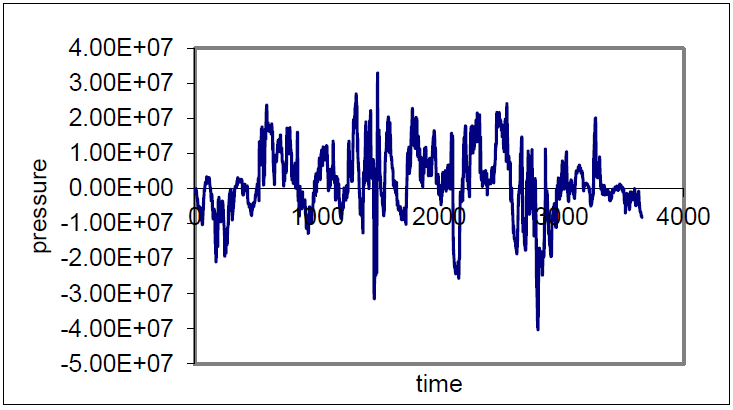
The implementation of statistical and probabilistic input data processing allows stabilizing the process of the gas volume determination in the pipeline and determining the necessary processing parameters: the number of measurements, time interval, etc.
Identifying the nature of gas movement in the pipeline, stationary or non-stationary, is another objective, which is solved using the Fourier-Jacobi series. The zero Fourier-Legendre coefficient determines the arithmetic average of the measured value in the corresponding interval. The first coefficient expresses the mathematical expectation of a random value. Based on an analysis of the numerical results, we can follow up: if the first Fourier-Jacobi coefficient is smaller than one, then the gas movement process is stable; otherwise – it is non-stationary.
5. Inversion of one-dimensional Volterra convolution
Obtaining digital information about the explored objects is associated with various types of inaccuracies – additive or multiplicative. Additive inaccuracies are sufficiently well filtered by approximating the received signal. As a rule, filtering multiplicative noises is solved by integral equations, the cores of which are functions of the medium capacity. Quite often, integral equations may be approximated by convolutional integral equations
$$\alpha f(t) + \mu \int_0^t k'(t – \tau) f(\tau)\, d\tau = y(t),\tag{11}$$
$$\mu \int_0^t k(t – \tau) f(\tau)\, d\tau = y(t).\tag{12}$$
The problem of filtering multiplicative noises in linear filter models of signals, information processing, lidar equations, etc. may be solved by such equations [1, 5, 8, 20]. Here 𝛼, 𝜇- some constants, 𝑓(𝑡)- the desired function, 𝑘(𝑡)- the equation core. Equations (11) and (12) can be easily solved by operational methods based on the integral Laplace transformation. When input information is presented as discrete data, then it is necessary to apply numerical methods. The main ways to solve integral equations of the 1st type convolution is the utilization of regularization algorithms of the Tikhonov type or the discretization of the direct origin equation. However, these methods have some disadvantages [2, 20].
The use of Tikhonov-type algorithms leads to a loss of Volterra stability, which significantly reduces the ability to restore the searched functions for the areas under consideration and demands the implementation of small grid steps.
The main disadvantage of the second method is the lack of accounting for the instability of the digital solution to inaccuracy in the input information. That leads to the case when the solution of the perturbed equation is beyond the set of correctness. Furthermore, not all quadrature formulas give rise to convergent methods.
Algorithm for solving integral equations (11) and (12) in the Chebyshev-Laguerre basis \(L_n^{\lambda}(t), \quad \lambda > -1\). [5] It is assumed that the functions included in integral equations (11) and (12) satisfy the conditions that allow them to be represented by the Fourier-Laguerre series (4). Then, if 𝑓(𝑡) is the restoring signal, then the determination of the unknown coefficients 𝑓𝑛. will ensure the search solution.
Solution of equation (11). It is convenient to write equation (10) as follows
$$\left( \alpha – \mu\,k(0) \right) f(t) + \mu \frac{d}{dt} \int_0^t k(t – \tau)\,f(\tau)\,d\tau = y(t).$$
If 𝜆=0, then there is a formula for calculating the unknown coefficients
$$f_n = \frac{1}{\alpha + \mu (k_0 – k(0))} \left( y_n – \mu \sum_{m=1}^n k_m f_{n-m} \right).\tag{13}$$
Here 𝑘𝑚 and 𝑓𝑚 are the Fourier-Laguerre coefficients of the functions 𝑘(𝑡) and 𝑓(𝑡), respectively. Since the coefficients 𝑘𝑘𝑛𝑛and 𝑦𝑦𝑛𝑛 are known, the Lager spectrum of the unknown function 𝑓(𝑡).is determined by the formula (13). Thus, equation (11) can be considered resolved.
Similarly, the solution of equation (11) is obtained. Let the functions 𝑘(𝑡) and 𝑓(𝑡) be given in series by polynomials \(L_n^{\lambda_k}(t), \quad \lambda_k > -1,\) and \(L_n^{\lambda_f}(t), \quad \lambda_f > -1,\) respectively, then the Fourier-Laguerre coefficients for the desired solution are calculated by the formula
$$f_n = \frac{1}{k_0} \left( \frac{1}{\mu} y_n – \sum_{m=0}^{n-1} k_{n-m} f_m \right). \tag{14}$$
Here 𝑦𝑛 are the Fourier-Laguerre coefficients of the function 𝑦(𝑡) at 𝜆 = 𝜆𝑘+𝜆𝑓+1.
One of the advantages of the considered method is that the discretization procedure is excluded since the integral convolution turns into a series convolution. Quadrature formulas and formulas (13) and (14) enable the computation of a limited number of coefficients. These are not always sufficient to restore the original with the required accuracy. For this disadvantage elimination, asymptotic formulas for large 𝑛𝑛 were derived in the research that applies a priori information. They allow building a regularizing algorithm for restoring the desired function 𝑓(𝑡) with an accuracy that is acceptable for practice.
Modification of the constructed scheme. It is advisable to modify the above spectral method of solving convolution-type integral equations in a way as to restore values 𝑓(𝑡) by values 𝑦(𝑡𝑖) at the given points. To do this, we write formula (14) in the form
$$y_n = \sum_{m=0}^{n} k_{n-m} f_m,$$
or in matrix form
$$K_N F_N = Y_N, \tag{15}$$
where
$$K_N = \begin{pmatrix} k_0 & 0 & \cdots & 0 \\ k_1 & k_0 & \cdots & 0 \\ \vdots & \vdots & \ddots & \vdots \\ k_{N_1} & k_{N_1-2} & \cdots & k_0 \end{pmatrix}, \quad F_N = \begin{pmatrix} f_0 \\ k_1 \\ \vdots \\ f_{N_1} \end{pmatrix}, \quad Y_N = \begin{pmatrix} y_0 \\ y_1 \\ \vdots \\ y_{N_1} \end{pmatrix}.$$
The unknown coefficients 𝑓𝑛 will be the solutions of the matrix equation (14)
$$F_N = K_N^{-1} Y_N.$$
Here \(K_N^{-1}\) is the matrix inverted to 𝐾𝑁. In expanded form
$$f_n = \sum_{i=0}^{N-1} y_i \, z_{n,i}, \quad n = \overline{0,N-1}. \tag{16}$$
The last formula 𝑧𝑧𝑛𝑛,𝑖𝑖 contains the elements of the inverse matrix\(K_N^{-1}\). Substitute formula (14) into the N-th partial sum of the Fourier-Laguerre series. As a result, we get approximate equality for recovery 𝑓(𝑡)≈𝑓𝑁(𝑡)
$$f_N(t) = \sum_{n=0}^{N-1} \eta_n^{\lambda}(t)\, y_n, \tag{17}$$
where
$$\eta_n^{\lambda}(t) = t^{\lambda} \sum_{m=n}^{N-1} \frac{n!}{\Gamma(n + \lambda + 1)}\, z_{n+1,m+1}\, L_m^{\lambda}(t).$$
The quadrature formula for calculating the expansion coefficients 𝑦(𝑡) in matrix form is written as follows
$$
where 𝑊𝑁,𝑁 is a square matrix 𝑁∗𝑁 with elements 𝜔𝑖,𝑗, and 𝑌𝑇𝑁 is a column matrix with elements 𝑦(𝑡𝑗), 𝑗 = \(\overline{0,N-1}\).
If the values of the function 𝑓(𝑡) are calculated in points 𝑡𝑘, 𝑘 = \(overline{1,K}\), then equality (17) will be in the matrix representation
$$\begin{pmatrix} f(t_1) \\ f(t_2) \\ \vdots \\ f(t_K) \end{pmatrix} = \begin{pmatrix} \eta_0(t_1) & \eta_1(t_1) & \dots & \eta_{N-1}(t_1) \\ \eta_0(t_2) & \eta_1(t_2) & \dots & \eta_{N-1}(t_2) \\ \vdots & \vdots & \ddots & \vdots \\ \eta_0(t_K) & \eta_1(t_K) & \dots & \eta_{N-1}(t_K) \end{pmatrix} \begin{pmatrix} y_0 \\ y_1 \\ \vdots \\ y_K \end{pmatrix},$$
or
$$FT_K = \Theta_{K,N} Y_N. \tag{19}$$
Therefore, from formulas (17) and (18) we obtain the next formulas
$$FT_N = G_{K,N} YT_N, \quad G_{K,N} = \Theta_{K,N} W_{N,N}. \tag{20}$$
Since the matrix KNG, is constructed, then equality (20) allows us to restore the values of the input signal based on the values of the output signal at the points 𝑡𝑘, 𝑘 = \(overline{1,K}\).
The elements of the matrix do not depend on the values of the input and output signals. Therefore, it is possible to calculate their required number with specified accuracy by using specific software methods and storing them in the warehouse. This helps to save calculation time and reduce the accumulation of calculation errors.
6. Use of spectral methods in vegetation remote-sensing
The natural and physical phenomena investigation frequently is performed based on remote or spectroscopic data. This helps to obtain information on the studied objects without performing natural experiments, chemical or other analyses. The use of mathematical modeling allows us to save both financial and material costs, as well as research time.
Spectrometric surveys of objects using a remote method allow the detection of certain deviations in the spectra of the reflected signals from the background ones. Studying the difference between reflected and background signals makes it possible to identify these objects or detect the presence of impurities within them. Through remote spectrometric surveys, it is possible to detect certain deviations in the anomalous reflection spectra of plants from their background values [5, 6, 8, 18, 21]. Based on this, using the data of ground reconciliation and calibration works, the mapping of vegetation areas with anomalous spectral characteristics is easily performed. Effective methods for plant reflectance spectra processing, which must satisfy the given criteria, in particular, in terms of accuracy and extreme qualities should be developed to solve such type problems. The basis of Jacobi polynomials will be used to complete such problems. The input data for a specific interval of wavelengths is shown in Figure 2.
The reflected signal is approximated by the partial sum of the Fourier-Jacobi series
$$f(x) = \begin{cases} \omega(x) \\ 1 \end{cases} \sum_{n=0}^{\infty} \begin{cases} f_n \\ \hat{f}_n \end{cases} \frac{1}{r_n} P_n^{(\alpha,\beta)}(x), \quad x \in [-1,1], \tag{21}$$
$$\begin{cases} f_n \\ \hat{f}_n \end{cases} = \int_{-1}^{1} \begin{cases} 1 \\ \omega(x) \end{cases} P_n^{(\alpha,\beta)}(x) f(x)\,dx.$$
It is advisable to use formula (8) to calculate the unknown coefficients 𝑓𝑛 as, during information processing, the values of the signals are known mainly at discrete points.
Contamination of plants by nitrates is known to cause disturbance of the reflected spectrum at wavelengths of 450 nm to 650 nm [5], and the number of nitrates may be determined after calibration by chemical samples for nitrate content by the deviation
$$\Delta f = f_{f_{\max}}(x_m) – f_{a_{\max}}(x_m)$$
at the maximum point 𝑥=𝑥𝑚 (Fig. 1). Here, 𝑓𝑓 and 𝑓𝑎 are the value of the background and reflected spectra, respectively. Approximation of the reflected signal by various methods leads to the fact that the maximum point in the general case does not coincide with the background spectrum maximum point. This causes inaccuracy in the determination of the abnormal signal distribution Δf. Jacobi polynomials usage allows matching the coordinates of the background maximum and reflected spectra due to the presence of two free parameters 𝛼 and 𝛽. Thus, the deviation of the reflected spectrum from the background spectrum is determined with specific accuracy.
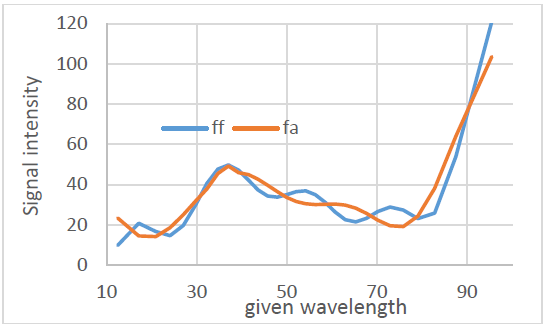
The identification algorithm is as follows.
a) The Fourier-Jacobi coefficients 𝑓𝑓n and 𝑓𝑎n \(\left( n = \overline{0,NV} \right)\) are calculated based on the values of the 𝑓𝑓(𝜆𝑖) background and 𝑓𝑎(𝜆𝑖) reflected spectra.
b) The points of maximum 𝑥𝑓m and 𝑥𝑎m for the background and reflected spectra at the given values 𝛼 and 𝛽 in the interval 450-650 nm are obtained as solution of the below equations:
$$\sum_{n=0}^{NV} \frac{f_n}{r_n} \left\{ (\beta – \alpha – (\alpha + \beta)x) P_n^{(\alpha,\beta)}(x) + \frac{1}{2n + \alpha + \beta} \left( (\alpha – \beta + (2n + \alpha + \beta)x) P_n^{(\alpha,\beta)}(x) – 2(n + \alpha)(n + \beta) P_{n-1}^{(\alpha,\beta)}(x) \right) \right\}$$
$$= 0$$
and
$$\sum_{n=0}^{NV} \frac{\hat{f}_n}{r_n (2n + \alpha + \beta)} \left\{ n(\alpha – \beta – (2n + \alpha + \beta)x) P_n^{(\alpha,\beta)}(x) + 2(n + \alpha)(n + \beta) P_{n-1}^{(\alpha,\beta)}(x) \right\} = 0$$
The values of 𝛼 and 𝛽 are chosen in such a way that equality takes place 𝑥𝑚 = 𝑥𝑓𝑚 = 𝑥𝑎𝑚 .
с) The values of the background 𝑓𝑓 and 𝛥𝑓 anomalous 𝑓𝑎 reflected spectra and their difference 𝛥𝑓 = 𝑓𝑎(𝑥𝑚) − 𝑓𝑓(𝑥𝑚) are calculated at the found maximum point. The values of 𝑥𝑚 and 𝛥𝑓 at different values of 𝛼 and 𝛽 are presented in Table 1. The row marked with I corresponds to the case when the multiplier before the sum in equation (21) is equal to one, while the row marked with II – 𝜔(𝑥). The analysis of the data presented in Table 1 illustrates that for each 𝛼 there are such values 𝛽, at which 𝛥𝑓 is constant. Persistence of disturbance of the background spectrum 𝛥𝑓 serves as a criterion for the optimal choice of parameters 𝛼 and 𝛽 for the remote data spectrometry of plants under processing.
Table 1: The value of disturbance of the background spectrum 𝛥𝑓 of plant reflection at the xm maximum point for different 𝛼 and 𝛽 parameters.
-0.6 | -0.28 | 0.04 | 0.36 | 0.68 | |||||||
| 𝑥𝑚 | 𝛥𝑓 | 𝑥𝑚 | 𝛥𝑓 | 𝑥𝑚 | 𝛥𝑓 | 𝑥𝑚 | 𝛥𝑓 | 𝑥𝑚 | 𝛥𝑓 | ||
-0.5 | I | 577.6 | 3.84 | 578.1 | 3.89 | 578.5 | 3.70 | 578.9 | 3.54 | 579.3 | 3.43 |
II | 543.8 | 6.18 | 596.9 | 3.53 | 543.7 | 6.33 | 545.6 | 6.58 | 533.0 | 9.87 | |
0.0 | I | 577.4 | 4.17 | 577.9 | 3.97 | 578.3 | 3.77 | 578.7 | 3.59 | 579.1 | 3.46 |
II | 544.4 | 6.47 | 597.4 | 0.43 | 544.2 | 6.42 | 545.3 | 6.58 | 548.8 | 6.85 | |
1.0 | I | 577.0 | 4.32 | 577.5 | 4.16 | 577.9 | 3.98 | 578.3 | 3.80 | 578.7 | 3.64 |
II | 570.9 | 7.16 | 569.8 | 6.73 | 529.5 | 5.98 | 529.2 | 5.90 | 529.1 | 5.84 | |
The deviations of the reflected spectrum from the background obtained during the computational experiment were compared with the corresponding results obtained based on chemical analysis during the natural experiment. The convergence of results was within 15%. Therefore, the presence of nitrates in plants and the estimation of their percentage rate can be detected by the processing of remote data of green areas. Similarly, it is possible to detect the presence of heavy metals in green vegetation. For this purpose, it is necessary to investigate the deviation of the reflected spectrum from the background in the so-called “blue shift” zone, that is, at wavelengths longer than 2000 nm. In particular, this will allow determining the area of radioactive contamination spreading by remote methods without the risk of exposure to specialists.
7. Conclusions and discussion.
An algorithm for remote and spectroscopic information processing using the spectral method based on orthogonal Jacobi and Chebyshev-Laguerre polynomials is presented in the current paper. This algorithm allows approximating signals by orthogonal series, calculating the derivatives of the specified series, and solving approximation and identification problems on this basis. The feasibility and effectiveness of orthogonal Jacobi and Chebyshev-Laguerre polynomials used to solve signal-processing problems have been confirmed based on real-life data. The problem of the summation of the orthogonal basis series is incorrect. The optimal choice of free parameters makes it possible to provide an “implicit regularisation” by applying the fast convergence series. Depending on the specifics of the problem, the procedures for speeding up the convergence of series or modifying the functions with orthogonal series may be utilized for this purpose.
Based on the input information, the Fourier-Jacobi series can be presented in the following form:
$$\varphi(x) = \omega(x) \sum_{n=0}^{\infty} \frac{\varphi_{\omega n}}{r_n} P_n^{(\alpha,\beta)}(x),$$
$$\varphi(x) = (1 – x)^{\alpha} \sum_{n=0}^{\infty} \frac{\varphi_{\alpha n}}{r_n} P_n^{(\alpha,\beta)}(x),$$
$$\varphi(x) = (1 + x)^{\beta} \sum_{n=0}^{\infty} \frac{\varphi_{\beta n}}{r_n} P_n^{(\alpha,\beta)}(x).$$
A similar procedure can be provided with the Fourier-Laguerre series.
One of the reasons for the usage of classical orthogonal polynomials widespread is that they are easy to use and theoretically justified. Recently, intensive research has been done regarding constructing and applying biorthogonal polynomials to solve applied problems.
Algorithms for filtering one-dimensional signals in linear filter models were built based on one-dimensional Laguerre polynomials. One of the advantages here is that the integral convolution moves directly to series convolution without using the discretization procedure. In practice, it is necessary to consider models of filtering signals of higher dimensions, particularly two-dimensional ones. In such cases, it is advisable to use multidimensional orthogonal Laguerre polynomials. Studies of these polynomials types were conducted in works [15, 16, 19]. The results obtained in these works can be successfully used for filtering multidimensional signals. Note that in practice, as a rule, signal filtering models are non-linear. However, a considerable number of signal filtering problems in nonlinear models can be solved with sufficient accuracy for practice by approximating them with linear filter models.
Conflict of Interest
The authors declare no conflict of interest.
- Bat Markus, “Spectral analysis in geophysics,” – M.: Nedra, 1980. – 535 p.
- Y.D. Pyanilo, “Projection-iterative methods for solving direct and inverse transfer problems,” Lviv: Spline. 2011. 248 p.
- Y. Pjanylo, O. Hotra, “Methods of statistical processing of measurements data in the basis of jacobi polynomial for ecological monitoring,” Actual Problems of Economics, 2010, (10), pp. 221–230.
- Y. Pyanylo, V. Sobko, H. Pyanylo, M. Petrus, A. Demichkovsky, “Processing of Digital Information on the Basis of Orthogonal and Biorthogonal Polynomials,” 2020 IEEE 6th International Conference on Methods and Systems of Navigation and Motion Control, MSNMC 2020 – Proceedings, 2020, pp. 114–117, 9255422
- V.I. Lyalko, Y.D. Pyanylo, “The use of classical orthogonal polynomials in remote sensing of vegetation,” Add. National Academy of Sciences, No. 2, 1997. p. 42-46.
- Z.M. Shportyuk, V.I. Lyalko, Y.D. Pyanilo, O.M. Sibirtseva, H.M. Pyanilo, “Spectral methods of information processing and analysis in remote sensing of vegetation,” Preprint of NU TsMM IPPMM ANU No. 4-93, Lviv, 1993 – 54 c.
- Global system of observation of the planet Earth [Electronic resource] — Mode of access to the resource: https://goo.gl/uuhmCk.
- S. O. Dovgiy, V. I. Lyalko, S. M. Babiichuk, T. L. Kuchma, O. V. Tomchenko, L. Ya. Yurkiv, “Basics of remote sensing of the Earth: history and practical application: education manual,” – K.: Institute of the Gifted Child of the National Academy of Sciences of Ukraine, 2019. — 316 p.
- J. Shen, “Efficient spectral-Galerkin method II. Direct solvers for second- and fourthorder equations by using Chebyshev polynomials,” SIAM J. Sci. Comput. 16. 1995. P. 74–87.
https://doi.org/10.1137/0916006 - Y.D. P’yanylo, H.M. P’yanylo, M.Y. Vasiunyk, “Application of orthogonal polynomials for analysis of input numerical data in the problems of mass transfer,” Mathematical Modeling and Computingthis , 2015, 2(1), pp. 88–98. DOI: https://doi.org/10.23939/mmc2015.01.088
- Y. Pyanylo, V. Sobko, O. Bratash, “The mass transfer research in complex porous media and pipelines by spectral methods,” Mathematical Modeling and Computingthis , 2017, 4(2), pp. 187–196. DOI: https://doi.org/10.23939/mmc2017.02.187
- K. Lantsosh, “Practical methods of applied analysis,” – Moscow: Fizmatgiz, 1961. – 524p.
- S. Kachmazh, G. Shteinhaus, “Theory of orthogonal series,” – Moscow: Fizmatgiz. 1958. 394 p.
- Y. D. P’yanylo, V. G. Sobko, “Construction and research of biorthogonal polynomials based on Chebyshev polynomials,” Applied problems of mechanics and mathematics. 2013. Issue 11. P. 135–141.
- N. U. Khan, T. Usman, and W. A. Khan, “A new class of laguerre-based generalized hermite-euler polynomials and its properties,” Kragujevac Journal of Mathematics. Volume 44(1) (2020), P. 89–100. DOI: 10.46793/KgJMat2001.089K
- W.A. Khan and H. Haroon, “A new class of generalized Laguerre-based poly-Bernoulli polynomials,” Global Journal of Pure and Applied Mathematics. ISSN 0973-1768 Volume 13, Number 8 (2017), P. 4175–4188. http://www.ripublication.com/gjpam.htm
- Yu. Luk, “Special mathematical functions and their approximation,” -M: Mir, 1980. -608 p.
- Drones and satellites: monitoring the condition of crops during season [Electronic resource]. — 2017. — Mode of access to the resource: https://smartfarming.ua/ua-blog/monitoring-sostoyaniya-posevov-vtechenie-sezona.
- W. A. Khan, S. Araci, M. Acikgoz and A. Esi, “Laguerre-based Hermite-Bernoulli polynomials associated withbilateral series,” Tbilisi Mathematical Journal 11(2) (2018), pp. 111–121. DOI: 10.32513/tbilisi/1529460026
- A.N. Tikhonov, V.Ya. Arsenyn, “Methods of solving incorrect problems,” 2nd ed. Moscow: Nauka: Main edition of physical and mathematical literature. 1979. 285 p.
- Heat balance of the Earth [Electronic resource] — Access mode to the resource: https://uk.wikipedia.org/Teplovy_balans_Zemli.
No. of Downloads per Month
No. of Downloads per Country
The paper deals with proposals for the procedure of selecting the parameters of the sine-wave filter in case of increased voltage frequency (400—600 Hz) on the output of frequency converter, which is an element of power supply system. Author describes in article the structure of the power supply system for an unmanned underwater vehicle, which contains a sine-wave filter connected to frequency converter output. The system’s simulator has a block structure. As blocks previously developed computer models of electrical devices (transformer, autonomous voltage inverter, L-shaped filter, rectifier) are used. The subject of sine-wave filter output voltage quality and contribution to this of input voltage’s modulation index is also described at 100—200 Hz.
1. Introduction
Computer simulation today is one of the most popular and wide-spread information technologies used for the analysis and synthesis of technical systems, the consideration of electromagnetic, mechanical, thermal and other processes in them (sometimes under conditions that are difficult or impossible to apply to a real technical device). Computer simulation allows us to reduce the cost of devices development, reducing the materials and time consumption, but at the same time as above consider many different options of construction and modes. This allow specialists to recognize unsuccessful technical solutions before failure occurs or other negative impact during operation and apply acceptable methods to fix them at various stages of the device lifecycle.
For a contemporary electric drive based on frequency controlled AC motors and for a power supply systems (PSS) which include a frequency converter (FC), the problem of electromagnetic compatibility is one of the most ones due to the features of technology of voltage generation by pulsed converters based on semiconductor switches. The output voltage of pulsed converters is formed as a sequence of pulses of trapezoidal shapes. Every pulse has very steep fronts. Such a voltage contains a wide range of higher time harmonics. An additional losses of energy for all elements of the electric circuit from the FC output to the load occurs because of this. One way to reduce the influence of higher time harmonics is the EMC filters installation [1, 2] to suppress them. The sine-wave filter (SF) [3, 4] is one of filter types for FC output voltage.
Author should like to describe and gradually consider have applied by him procedure of the SF parameters selection for increased up to 400—600 Hz frequency of voltage. Proposed parameters selection procedure takes into account the possibility of operating the SF in the fundamental harmonic’s frequency range. On other hand, the subject of SF output voltage quality and factors contributes to it is interesting.
2. The Initial Data and Limitations
The authors of [5-10] articles propose description of the PSS used for powering unmanned underwater vehicles. Figure 1 presents an example of underwater vehicle MCC-3000 produced by LLC Marine Geo Service (Moscow, Russia). Underwater vehicle’s PSS contain (Figure 2): a source of balanced three line-to-line voltage of 380 V RMS value at 50 Hz frequency; FC structure contains a 3-phase input rectifier 1 (diodes D7 – D12), DC voltage link 1 ( Ld1 , Cd1 as an L-shaped filter) and a 3-phase two-level autonomous voltage inverter (AVI) pulse width modulated (PWM) output voltage with frequency control (diodes D1 – D6 and IGBT T1 – T6), the FC’s output voltage fundamental harmonic frequency is f1 = 400—600 Hz in steady-state operation; SF ( RLSF , LSF , CSF , RCSF as 3-phase L-shaped filter); 3-phase step-up transformer (PT1); cable-umbilical ( RC , LC , CC ); 3-phase step-down transformer (PT2); 3-phase rectifier 2 (diodes D13 – D18); DC voltage link 2 ( Ld2 , Cd2 as an L-shaped filter) and an equivalent load in the form of resistance Rload. The DC voltage link 2 and the rectifier 2 represent the head part of another FC, which also includes another AVI, from which the wide speed range frequency controlled electric drive of propellers based on 3-phase synchronous AC motors is powered. In Figure 2 instead of these electric drive and AVI the resistor Rload drawn.
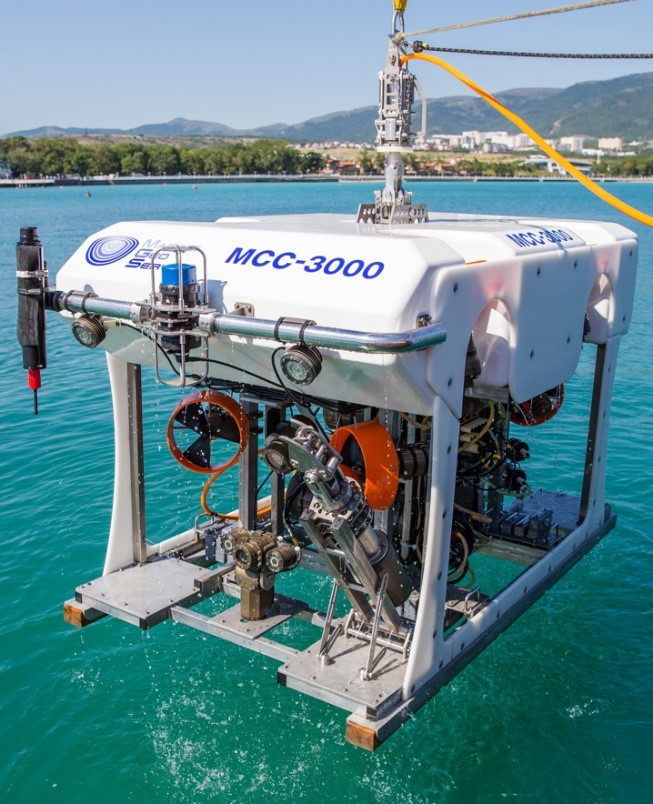
Marine Geo Service (Moscow, Russia)
fPWM = 14 kHz – is the PWM carrier frequency. The FC’s power is limited. That is the value of FC’s output current at long-term mode is limited. The same value IL∑ will have a current through inductance LSF of the SF phase. The LSF value is limited by the permissible voltage drop on it (percent impedance (short-circuit voltage vsc, %, equation (1))) caused by the current at long-term mode (for example, 10 % of the phase voltage fundamental harmonic RMS value). Needless to say, that FC’s output current IL∑ will contain wide harmonic spectrum. The voltage drop on the inductance caused by each current harmonic will be proportional to this harmonic frequency. Therefore, it is convenient to assume that the permissible voltage drop should occur from the flow through the inductor of only fundamental (first) current IL1 harmonic as a limitation for LSF calculations. The RMS value of the FC output current fundamental harmonic we can define through the usage of the power supplied by the primary 3-phase voltage source, the rated load power, the efficiency of devices (cables, transformers, rectifiers) series connected in the PSS. The resistance RLSF of the SF inductor phase LSF can be determined approximately in accordance with [1].
3. The Adopted Values for Parameters of Devices During Simulation
The SF of type Schaffner FN5020-75-35 parameters, being measured by the specialists of LLC Marine Geo Service (Moscow), in addition to the characteristics published in [11], are represented in Table 1, where Vp-p – the line-to-line voltage rated RMS value, f0 – the SF resonance frequency, Irated – the current through RLSF , LSF branch rated RMS value (FC rated output current).
$$v_{sc,\%} = \frac{\sqrt{3} I_{\text{rated}} \sqrt{(2 \pi f_1 L_{SF})^2 + R_{LSF}^2}}{V_{p-p}} \cdot 100\% \tag{1}$$
$$f_0 = \frac{1}{2 \pi \sqrt{L_{SF} C_{SFY}}}.\tag{2}$$
In equation (2) as CSFY we mean Y connection of SF phases capacitances. In case of Δ connection of capacitances will be true equation (3)
$$\begin{equation}
C_{SF\Delta} = \frac{C_{SFY}}{3}.
\end{equation}\tag{3}$$
For the cable-umbilical type KG (3×3,0+1×0,75+2x3E)-190-60 with a length of 3.4 km, based on its geometric dimensions, during simulation the parameters RC = 21.964 Ω , LC = 0.108 mH and CC = 0.168 µF have used. Author has used concentrated parameters for cable simulation. In accordance with data published in [6] it gives a slight discrepancy in the load voltage results compared to the model with distributed parameters (<6 %) and experimental data (within 5 %).
Both PT1 and PT2, which are part of the PSS, are constructed as a transformer group of three toroidal single-phase transformers inside the common protective shell. PT1 is the type OSM T 380/1900-12.0-400. PT2 is the type OSM T 1900/240-10.0-400. Each phase of PT1 and PT2 has a separate magnetic circuit. Because of this fact, a mathematical model of a 3-phase transformer without magnetic coupling between the phases (3 connected to each other models of single-phase transformer) has used. The approximate parameters of the T-shaped equivalent circuit of transformer [12] and characteristics used for the simulation of PT1 and PT2 are presented in Table 2. Magnetic saturation [13, 14] not taken into account.
For the AVI simulation, the computer model based on idealized switches has used, similar to published in [1, 14], with the difference that in the control system had to reduce the capacitance of the capacitors from 10 nF (the value used in [1, 15] at fPWM = 1-2.5 kHz) to 1 nF at fPWM = 14 kHz (you can find C1 = C2 =1 nF in Figure 3).
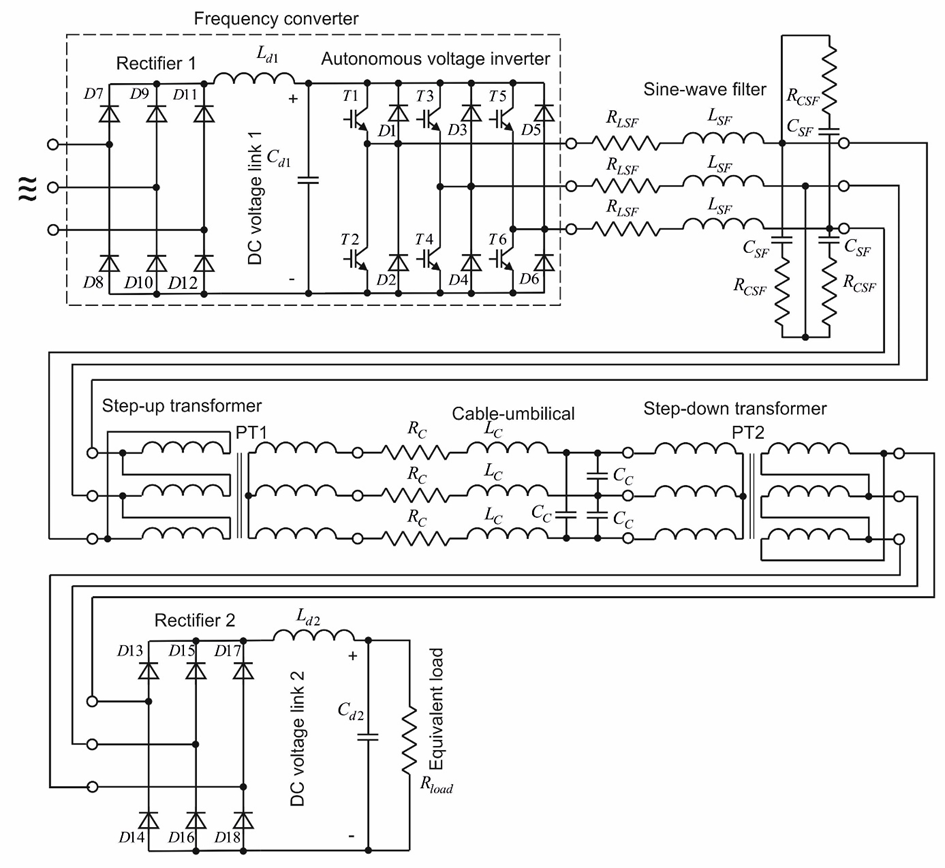
Table 1: Characteristics and Parameters of SF Type Schaffner FN5020-75-35
| f1 | Irated | Vp-p | LSF | RLSF | ||||
Hz | A | V | mH | mΩ | ||||
400 | 75 | 500 | 0.195 | 8.62 | ||||
600 | ||||||||
| CSF | RCSF | f0 | fPWM | $$\frac{f_{\mathrm{PWM}}}{f_0}$$ | vsc | |||
kHz | kHz | p.u. | % | |||||
8.5 | 10 | 2.3 | 14 | 6.2 | 13 | |||
19 | ||||||||
Table 2: Characteristics and Parameters for Simulation of 3-Phase Transformers
Name or symbol | Dimension | Value | ||||
for PT1 | for PT2 | |||||
T-shaped equivalent circuit parameters | Lσ1 | mH | 0.0191 | 1.286 | ||
| $$L’_{\sigma 2} = \left( \frac{w_1}{w_2} \right)^2 L_{\sigma 2} \approx \left( \frac{V_{1\,phase}}{V_{2\,phase}} \right)^2 L_{\sigma 2}$$ | ||||||
| r1 | mΩ | 5.7712 | 0.26 | |||
| r2 | 8.6567 | 0.173 | ||||
Connected in series | Lm | H | 0.0456 | 1.368 | ||
| rm | Ω | 21.83 | 654.875 | |||
The rated mode characteristics when powered by pure sinus voltage | V1phase – RMS value of primary winding phase voltage | V | 380 | 1900 | ||
V2phase – RMS value of secondary winding phase voltage | 1900 | 240 | ||||
Power on secondary winding terminals | kVA | 36 | 30 | |||
| f1 | Hz | 400 | ||||
Transformer’s current amplitude value at no load mode (close to magnetization current amplitude value at the rated mode) | A | 4.675 | 0.45 | |||
This shortens the pauses between switching off one and turning on the other switches at the same phase of the AVI model (for example, T2 and T1 in Figure 1a), and necessary to avoid the loss of short voltage pulses at the AVI output during simulation at high fPWM . The computer model of PSS implemented by means of PSpice [16-18]. For the DC voltage link simulation parameters of L-shaped filters shown in Table 3. These parameters determined according [15]. The load of the PSS (dissipates on Rload ) can vary from no-load mode to 45 kW overload. The rated power of PT1 is 36 kVA and 30 kVA for PT2.
4. The Suggested Sequence of Sine-Wave Filter Parameters Selection
- Let’s derive LSF from equation (1) on the base of permissible voltage drop caused by the IL1 . Generally recommended vsc, % = 10 %. may be neglected.
Table 3: Parameters values for L-shaped Filters of DC Voltage Links Simulation
| Ld1 | Ld2 | Cd1 | Cd2 |
mH | μF | ||
0.36 | 0.44 | 10700 | 9000 |
2. Set the frequency multiplicity $\frac{f_{\mathrm{PWM}}}{f_0}$ . For previously specified in this article fPWM and f1 values $\frac{f_{\mathrm{PWM}}}{f_0}$ = 5 – 7 is suitable. Generally, the frequency multiplicity should be such that the AVI’s output voltage higher harmonic components caused by (they have high amplitudes) would be damped. After that let’s find .
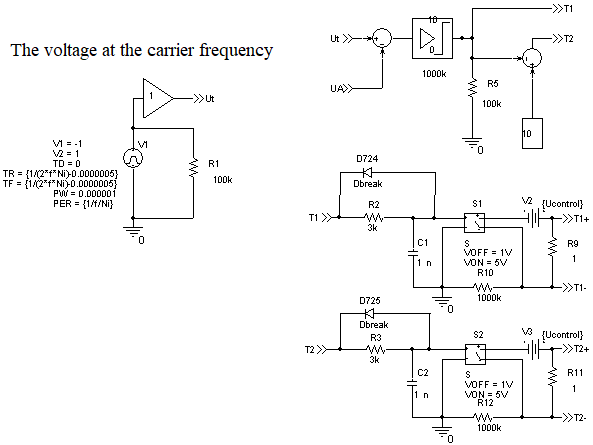
3. Knowing LSF and f0 values we’ll derive from equation (2) the capacitance CSFY per phase of the SF if there is the Y connection. When there is the Δ connection we’ll find CSFΔ from equation (3).
Table 4: Bode Diagram for the SF of Type Schaffner FN5020-75-35
f , Hz | 400 | 2000 | 2800 | 600 | 3000 | 4200 | |
# of time harmonic | 1 | 5 | 7 | 1 | 5 | 7 | |
Output SF voltage/ input SF voltage, p.u. | at no load condition | 1.03 | 5.21 | 1.87 | 1.08 | 1.30 | 0.40 |
at rated load | 1.03 | 3.57 | 1.70 | 1.07 | 1.23 | 0.39 | |
Table 5: Simulation Results for the SF of Type Schaffner FN5020-75-35, Characterizing the Voltages Harmonic Composition
f , Hz | 400 | 2000 | 2800 | 600 | 3000 | 4200 |
Time harmonic’s # | 1 | 5 | 7 | 1 | 5 | 7 |
Output SF voltage/ input SF voltage, p.u. | 1.036 | 2.374 | 2.401 | 1.129 | 1.095 | 0.622 |
$$\frac{THD_{V_{outputSF}},\ \%}{THD_{V_{inputSF}},\ \%}$$ (taken into account HTH till 240 kHz) | $$\frac{6.017}{42.143}$$ | $$\frac{4.235}{45.232}$$ | ||||
4. Next step author suggests to provide simulation for checking the SF with previously calculated parameters for the absence in the f1 operating range of resonant phenomena associated with a significant increase in the filter’s output voltage amplitude. For this purpose, PSS’s simulator building recommended. Let’s make computational experiment fulfillment during which the FC’s output voltage and frequency firstly increases to a maximum value (ascending part of the graph 1 in Figures 4 and 5), followed by a steady state (horizontal part of graph 1), lastly at the fixed maximum output voltage of the AVI, the frequency is slowly reduced to the lower f1 boundary (the slope of the graph 1). Figures 4 and 5 use the following notation: 1 – graph of 2f1 , Hz; 2 – graph of SF’s output line-to-line instantaneous voltage. First of all, the computational experiment should be performed at no load condition – in this case, the resonant phenomena, if they exist, are manifested to the greatest extent. In addition, it is possible to perform the similar simulation under load. If resonant phenomena detected, to move them out of the frequency f1 operating range, it is appropriate to increase the inductance LSF. If this is not desirable, you can reduce the filter capacity CSF. We need to remember that for the same inductor reduction in capacity leads to a deterioration of filtering properties, and the increase in capacity, although approximating the shape of the filter’s output voltage to sinusoidal, but results to an increase of the current through the capacitance, including by increasing of the fundamental harmonic, and hence increase the SF’s inductor current, that is, FC’s output current, which can lead to overload and shutdown of the FC. Simultaneous increase of capacitance and inductance results to an increase in the denominator of the equation (2), that is, to f0 decrease and its shift toward f1 . This can cause the fundamental voltage harmonic amplification, which, under constant load, will lead to an increase in IL∑ and IL1 .
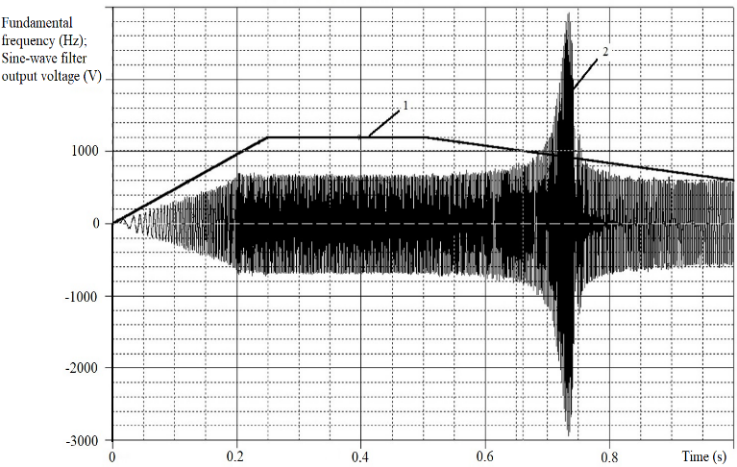
Figure 4: Results of simulation test for output voltage resonant phenomena in case of SF with LSF = 0.776 mH, CSFΔ = 20 μF and no load mode
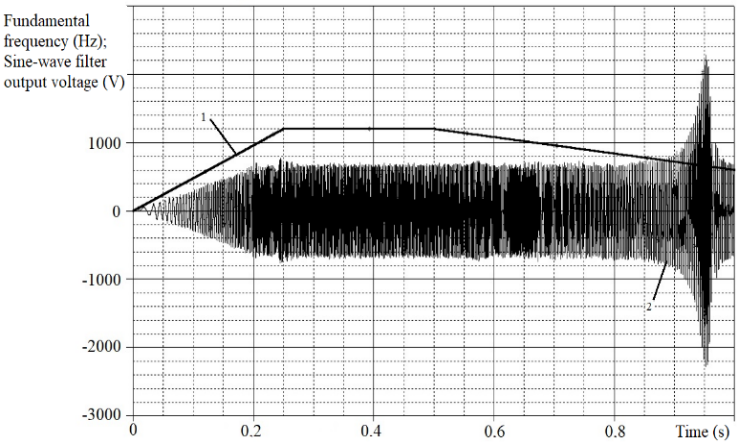
Figure 5: Results of simulation test for output voltage resonant phenomena in case of SF with LSF = 0.15 mH, CSFΔ = 20 μF and no-load mode
5. After all checking of the losses in the SF’s elements and the total power losses can be done. If the damping resistors in branches with capacitances are absent, we can estimate the series resistance connected with the phase capacitance of the order of units or tenths of (best – in accordance with the catalog data of capacitors). The focus on energy efficiency of equipment achievement, for example, in [19] is formulated as follows: “For two-level converters in the absence of various types of filters, these (additional due to non-sinusoidal supply voltage) losses can be … 1-2 % of the rated power of the motor. … there are losses in the filter, but they will be lower than the reduction of additional losses due to power from the converter. Thus, the total efficiency of the electric drive is increased.”
5. Justification of the Possibility of Increasing the Sine-Wave Filter’s Inductance Value
As we can see from Table 1, the SF type Schaffner FN5020-75-35 has vsc , % > 10 %. Let’s find out why this is allowed. In Figure 6 we can see the Bode diagram calculated for the SF type Schaffner FN5020-75-35. Table 4 contains the values of the same Bode diagram for some characteristic frequencies. From the Figure 6 and data Table 4 it follows that the SF voltage fundamental harmonic falls into the signal amplification region. One or both of the voltage’s lowest-frequency 5th and 7th highest time harmonics (HTH) also fall into there.
Bode diagram gives us a possibility to clarify the requirement to limit the voltage drop vsc , % in the SF’s phase inductor, which was limited to 10 % earlier, prohibiting voltage’s fundamental harmonic excessive weakening. Taking into account the SF output voltage’s fundamental harmonic gain, if necessary, we can assume vsc , % > 10 %, which has implemented for the SF type Schaffner FN5020-75-35 in accordance with Table 4 data.
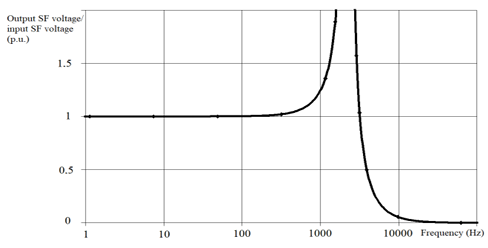
6. Simulated Voltages for Different Blocks of PSS
The results of steady state mode voltages simulation for different blocks of the PSS under load with SF type Schaffner FN5020-75-35 we can see in Figure 7 and Figure 8. The following notation have adopted: 1 – line-to-line voltage at the FC output (SF input); 2 – phase-to- phase output voltage of SF; 3 – line-to-line voltage of the low voltage (secondary) winding of PT2; 4 – voltage on Cd2 and on Rload = 4.8 Ω ; 5 – rectifier 2 output voltage.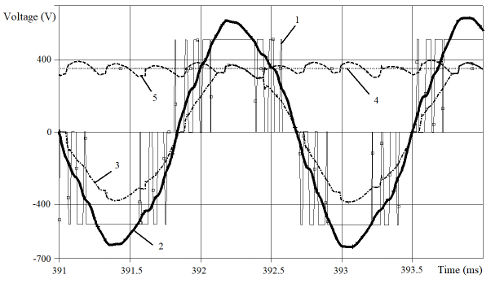
Figure 7: Simulated voltages for PSS at f1 = 600 Hz at 27.75 kW equivalent load
For the SF’s effectiveness demonstration Figure 9 and Figure 10 represent the spectral compositions of the line-to-line voltages at the SF’s input and output for the case shown in Figure 8.
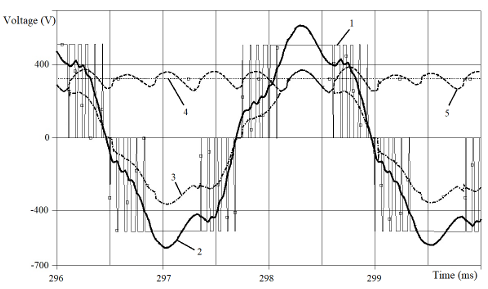
Figure 8: Simulated voltages for PSS at f1 = 400 Hz at 21.8 kW equivalent load
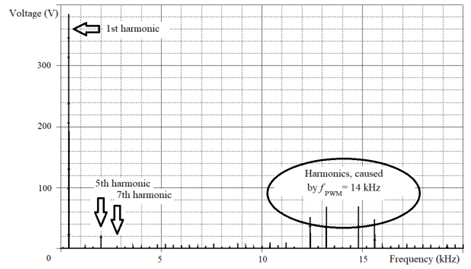
The comparison of Figure 9 and Figure 10 confirms that SF suppresses noticeably the HTH caused by fPWM , but, in accordance with Table 4 prediction, SF strengthens the 5th and 7th HTH, which causes the deformation of graphs 2 and 3 in Figure 8 especially. Also we can see that the voltage fundamental harmonic has amplified (Figure 10).
In Table 5 author summarize the processed results of Figure 7 and Figure 8 for the input and output line-to-line SF’s voltages. Needless to say, that results which Table 5 contains, in satisfactory agreement with the data of the Table 4 and Figure 6.
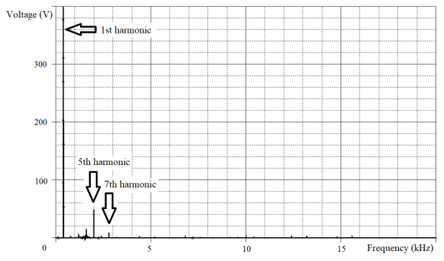
7. Impact Investigation of the DC Choke Ld2
We know, that the DC choke Ld2 may be absent in PSS. How does the voltage shape react to such a technical solution? In this case, the shape of voltages (graphs 2 and 3 in Figure 11, Figure 12) is close to pure sinus only at no load mode. While the load increases, the graph 2 shape deviates from the sine wave more and more. As we can understand from the harmonic analysis results, this occurs because of an increase of HTH with the 5th and 7th numbers in the voltage harmonic composition. At the same time, graph 3 will have flat (cut off) vertex.
Furthermore, the absolute value of the amplitude of graph 3 (the flat vertex) coincides with the graph 4 parts. Simulation results in Figures 11 and 12 developed at LSF = 0.16 mH and CSFΔ = 13 μF. We can make a conclusion, that when the output rectifier 2 loaded directly by the capacitance, it is possible that SF will provide a close to pure sinus output voltage wave shape, but at no load mode only. In Figure 13 presented the confirmation of this conclusion by voltage waveforms of the experimental PSS (got by specialists of LLC Marine Geo Service (Moscow, Russia)).
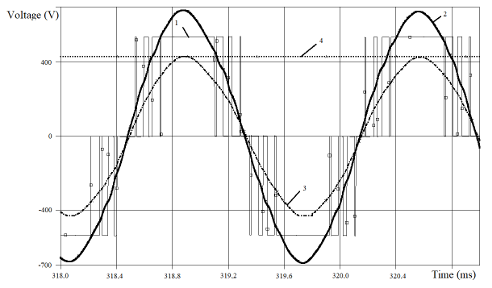
Figure 11: Simulated voltages for PSS without Ld2 at f1 = 600 Hz at no load mode

Figure 12: Simulated voltages for PSS without Ld2 at f1 = 600 Hz and 30.6 kW equivalent load value
The experimental results in Figure 13 got for LSF = 0.09932 mH and CSFΔ = 12 μF at an equivalent load of 10 kW. Figure 13 (a) demonstrates the line-to-line voltage on the secondary winding of a step-down transformer PT2 at f1 = 504 Hz; (b) line-to-line SF output voltage at 401 Hz.

8. FC Output Voltage Modulation Index Contribution to SF Output Voltage Quality
Currently, FC with SF connected at the output are also used as a regulated power supply for testing electrical equipment [20, 21]. For example, for conducting experiments of open circuit (no load) and short circuit of power transformers.
It is known that the no-load test is carried out at the rated voltage. Otherwise the short-circuit test of the transformer is carried out at a reduced supply voltage in order to limit the currents through the windings. That is, the FC, for example, can form rated output line-to-line voltage of 690 V RMS. The same FC has to form output line-to-line voltage of 200 … 250 V RMS at the transformer short circuit test mode. This is 29 … 36% of the rated voltage (rounded to 1/3). This is actually the PWM modulation index, the duty cycle of the pulses averaged over the period of the modulating voltage. Therefore, 2/3 of the time in the voltage period is occupied by pauses (see in Figure 14 and Figure 15 the experimental graphs of line-to-line output voltage for the 3-phase FC of type GoodDrive GD300 (manufactured in China) with rated power of 1000 kW).
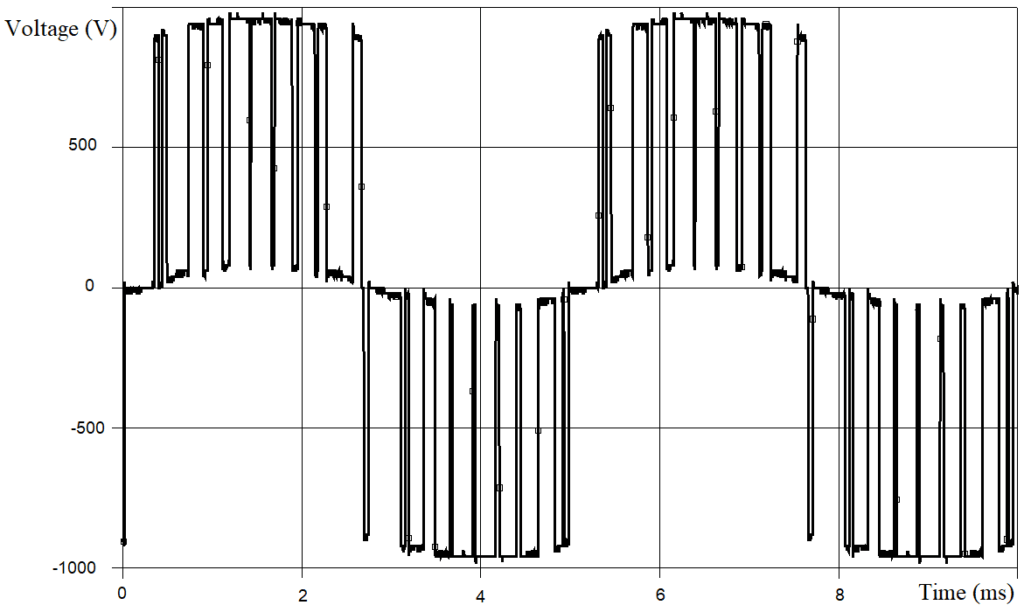
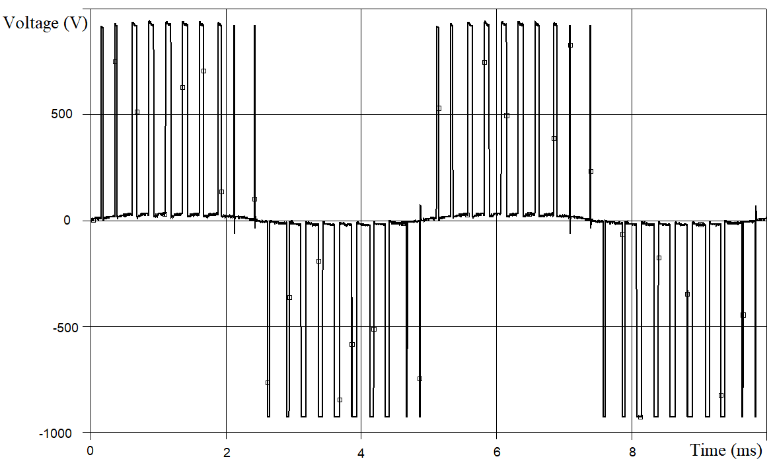
Figure 16 and Figure 17 show an experimental graphs of the line-to-line voltage at the SF’s output (SF equivalent parameters are LSF = 0.1 mH and CSFΔ = 240 μF (capacitances of SF phases connected in Δ scheme)). In all the experiments discussed in section 8 of this article, the PWM carrier frequency fPWM = 2 kHz.
Tables 6 and 7 show the results of harmonic analysis for the experimental graphs of line-to-line voltage at the FC output and at the SF output, respectively. In the tables 6 and 7 the HTH up to 1.6 MHz taken into account.
Test data for analysis provided by specialists of LLC Scientific and Production Enterprise “Electromash” (Novocherkassk, Russia).

Table 6: THDVinputSF , % Depending on the RMS Value of 1st Harmonic Line-to-line Voltage Specified for the Inverter Output
Fundamental frequency f1 , Hz | RMS value of the 1st harmonic line-to-line voltage specified for the inverter output, V | THDVinputSF , % |
50 | 200 | 164.5 |
100 | 200 | 161.3 |
150 | 200 | 160.5 |
200 | 200 | 162.0 |
50 | 600 | 59.9 |
100 | 600 | 60.1 |
150 | 600 | 60.5 |
200 | 600 | 61.8 |
Table 7: THDVinputSF , % Depending on the RMS Value of 1st Harmonic Line-to-line Voltage at the SF Output
Fundamental frequency f1 , Hz | RMS value of the 1st harmonic of line-to-line voltage at the SF output, V | THDVinputSF , % |
100 | 260.4 | 8.5 |
200 | 239.1 | 8.0 |
100 | 662.2 | 5.0 |
200 | 663.9 | 5.7 |
- M.Yu. Pustovetov, S.A. Voinash, “Analysis of dv/dt Filter Parameters Influence on its Characteristics. Filter Simulation Features,” 2019 International Conference on Industrial Engineering, Applications and Manufacturing (ICIEAM), pp. 1-8, 2019, doi:10.1109/ICIEAM.2019.8743007.
- C.F. Post, “EMC design considerations for medium to large variable speed drives in industry,” 2014 XXXIth URSI General Assembly and Scientific Symposium (URSI GASS), 2014, doi:10.1109/URSIGASS.2014.6929538.
- Baek Seunghoon, Choi Dongmin, Bu Hanyoung, Cho Younghoon 2020, “Analysis and Design of a Sine Wave Filter for GaN-Based Low-Voltage Variable Frequency Drives,” Electronics, vol. 9 (345), pp. 76-89, 2020, doi:10.3390/electronics9020345.
- E. Dresvianskii, M. Pokushko, A. Stupina, V. Panteleev, V. Yurdanova, “Control of high-voltage pump motor using a frequency sinewave filter converter,” IOP Conf. Ser.: Mater. Sci. Eng., vol. 450, p. 072003, 2018, doi:10.1088/1757-899X/450/7/072003.
- O. Sulaiman, A.H. Saharuddin, “Power Integrity Requirement of New Generation of ROV for Deep Sea Operation,” Global Journal of Researches in Engineering Automotive Engineering, vol. 12 (3), pp. 16-28, 2012.
- V.M. Rulevskiy, V.G. Bukreev, E.O. Kuleshova, E.B. Shandarova, S.M. Shandarov, Yu. Z. Vasilyeva, “The power supply system model of the process submersible device with AC power transmission over the cable-rope,” IOP Conf. Ser.: Mater. Sci. Eng., vol. 177 (1), p. 012098, 2017, doi:10.1088/1757-899X/177/1/012098.
- V.M. Rulevskiy, V.G. Bukreev, E.B. Shandarova, E.O. Kuleshova, S.M. Shandarov, Yu.Z. Vasilyeva “Mathematical model for the power supply system of an autonomous object with an AC power transmission over a cable rope,” IOP Conf. Ser.: Mater. Sci. Eng., vol. 177 (1), p. 012073, 2017, doi:10.1088/1757-899X/177/1/012073.
- V.M. Rulevskiy, V.A. Chekh, Y.A. Shurygin, A.A. Pravikova, “Voltage stabilizer in power supply of underwater vehicle,” IOP Conf. Ser.: Mater. Sci. Eng., vol. 327, p. 022018, 2018, doi:10.1088/1757-899X/327/2/022018.
- M.Yu. Pustovetov, “The Procedure of Sine-Wave Filter Parameters Selection Including Simulation in Case of Increased Frequency of Voltage,“ 2020 International Multi-Conference on Industrial Engineering and Modern Technologies (FarEastCon), 2020, doi:10.1109/FarEastCon50210.2020.9271606.
- V.М. Rulevskiy, A.A. Pravikova, D.Yu. Lyapunov, “Autonomous Inverters’ PWM Methods for Remotely Controlled Unmanned Underwater Vehicles,” 2016 International Conference on Industrial Engineering, Applications and Manufacturing (ICIEAM), 2016, doi:10.1109/ICIEAM.2016.7911641.
- Sine wave filters FN 5020 – SCHAFFNER Group – PDF Catalogs. https://pdf.directindustry.com/pdf/schaffner-group/sine-wave-filters-fn-5020/15134-878671.html
- M.Yu. Pustovetov, “A universal mathematical model of a three-phase transformer with a single magnetic core,” Russian Electrical Engineering, vol. 86 (2), pp.98-101, 2015, doi: 10.3103/S106837121502011X.
- M.Yu. Pustovetov, “Method for Taking into Account of Magnetization Curve Nonlinearity at Variable Frequency of Feeding Voltage,” 2018 International Conference on Industrial Engineering, Applications and Manufacturing (ICIEAM), 2018, doi:10.1109/ICIEAM.2018.8728613.
- M. Pustovetov, “An Inductive Coil Simulation,” International Journal of Power Systems, vol. 6, pp. 90-93, 2021
- M.Yu. Pustovetov, “Determination of the Sufficient Inductance of AC Line Reactor at the Input of Frequency Converter,” Journal of Modeling and Optimization, vol. 11 (1), pp. 25-29, 2019, doi:10.32732/jmo.2019.11.1.25.
- J. Keown, OrCAD PSpice and Circuit Analysis, Upper Saddle River: Prentice Hall, 2001.
- M.H. Rashid, SPICE for power electronics and electric power, CRC Press, 2012.
- A. Şchiop, V. Popescu, “PSpice simulation of power electronics circuit and induction motor drives,” Rev. Roum. Sci. Techn. – Électrotechn. et Énerg., vol. 52 (1), pp. 33–42, 2007.
- IEC TS 60034-25:2014 Rotating electrical machines — Part 25: AC electrical machines used in power drive systems — Application guide
- B. Leelachariyakul, P. Yutthagowith, “Resonant Power Frequency Converter and Application in High-Voltage and Partial Discharge Test of a Voltage Transformer,“ Energies, vol. 14, no. 7, p. 2014, 2021, doi:10.3390/en14072014.
- T. Prombud, P. Yutthagowith, “Development of High-voltage Testing System Based on Power Frequency Converter Used in Partial Discharge Tests of Potential Transformers,” Sensors and Materials, vol. 32, no. 2, pp. 573–585, 2020.
